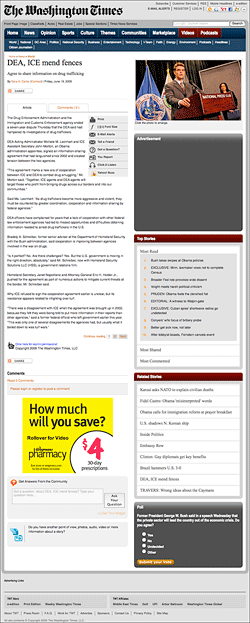June 19, 2009
|
DEA, ICE mend fencesAgree to share information on drug trafficking By: Sara A. Carter The Drug Enforcement Administration and the Immigration and Customs Enforcement agency ended a seven-year dispute Thursday that the DEA said had hampered its investigations of drug traffickers. DEA Acting Administrator Michele M. Leonhart and ICE Assistant Secretary John Morton, an Obama administration appointee, signed an information-sharing agreement that had languished since 2002 and created tension between the two agencies. “This agreement marks a new era of cooperation between ICE and DEA to combat drug smuggling,” Mr. Morton said. “Together, ICE agents and DEA agents will target those who profit from bringing drugs across our borders and into our communities.” Said Ms. Leonhart: “As drug traffickers become more aggressive and violent, they must be countered by greater coordination, cooperation and information sharing by federal agencies.” DEA officers have complained for years that a lack of cooperation with other federal law enforcement agencies had led to missed opportunities and difficulties obtaining information needed to arrest drug traffickers in the U.S. Bradely A. Schreiber, former senior adviser at the Department of Homeland Security with the Bush administration, said cooperation is improving between agencies involved in the war on drugs. “Is it perfect? No. Are there challenges? Yes. But the U.S. government is moving in the right direction, absolutely,” said Mr. Schreiber, now with Homeland Security Solutions LLC (HSS), a government relations firm. Homeland Secretary Janet Napolitano and Attorney General Eric H. Holder Jr., pushed for the agreement as part of numerous actions to mitigate current threats at the border, Mr. Schreiber said. Why ICE refused to sign the cooperation agreement earlier is unclear, but its resistance appears related to infighting over turf. “There was a disagreement with ICE when the agreement was brought up in 2002, because they felt they were being told to put more information in their reports than other agencies,” said a former federal official who left government earlier this year. “This was only one of several disagreements the agencies had, but usually what it boiled down to was turf wars.” The dispute behind Thursday's signing ceremony goes back to the Immigration and Naturalization Service, which preceded the creation of ICE in 2003. ICE has come under criticism for failing to cooperate with other federal departments. A Government Accountability Office report released this week criticized ICE and the Bureau of Alcohol, Tobacco, Firearms and Explosives for failing to work with each other. Rep. Eliot L. Engel, New York Democrat who heads a key oversight subcommittee, said an anti-gunrunning strategy should have been in place since October 2007, when the U.S. and Mexico agreed to the joint cartel-fighting Merida initiative. “It is mind-boggling that for a year and a half, we have had no interagency strategy to address this major problem, but instead have relied on uncoordinated efforts by a variety of agencies,” Mr. Engel said. ICE spokeswoman Kelly Nantel said the two agencies pride themselves “on the strength of our relationships with law enforcement partners at every level and throughout the country,” the Associated Press reported. Thursday's agreement between ICE and the DEA will allow ICE agents to investigate drug operations overseas in conjunction with the DEA and share information electronically through the Organized Crime Drug Enforcement Task Force (OCDETF) Fusion Center, which was created in 1982 to conduct comprehensive, multilevel campaigns against major drug trafficking and money laundering organizations. Access to the data base will allow the DEA, ICE, FBI and other participating agencies – including the U.S. Coast Guard and Bureau of Alcohol, Tobacco, Firearms and Explosives – to share case information and more effectively target criminals and avoid duplication of cases. “We knew after September 11 that information sharing was critical to preventing future terrorist attacks,” said a senior law enforcement official. “Hopefully, this will be a step in the right direction.” The official said the DEA had been urging ICE and its predecessor to sign the agreement since it became available in 2002, but that ICE had declined until Thursday. The official's claim was confirmed by a second law enforcement official. Both declined to be identified because of the sensitivity of the information. Improved information sharing among federal agencies was a key recommendation of the federal commission that investigated the Sept. 11 attacks. In recent years international drug cartels, especially in Mexico, have fiercely expanded their operations in the United States. Control over transit routes along the U.S. border with Mexico is central to smuggling billions of dollars in contraband and millions of people into the United States. The violence, which has spiraled out of control over the past several years, has led to the deaths of more than 8,000 people, including Mexican federal officers and police, forcing Mexican President Felipe Calderon to put the military in charge of the nation's drug war more than two years ago. In interviews with The Washington Times this year, Defense and DEA officials cautioned that the increased violence along the border and the growing nexus between various drug cartels and terrorist organizations – particularly Hezbollah – poses a significant security risk. These officials said there was no evidence that Hezbollah is engaged in terrorist activities in the U.S. and that its networks mainly serve to funnel money to the group's base in southern Lebanon. The interagency agreement signed Thursday is expected to enhance information sharing and increase the presence of agents along the U.S.-Mexico border. ICE will select an unlimited number of ICE agents to work with the DEA on drug smuggling cases that have a clear “nexus” involving the U.S. border with Mexico, according to a press release issued by both agencies. |

